
In addition to the back-end features offered by B2B Edition, your customers receive advanced capabilities designed to streamline the B2B buying experience. With Company accounts, your customers can create and manage their own user accounts, build orders with ease, complete checkout with pre-approved payment methods, and pay their invoices in one place.
The B2B Edition Buyer Portal
B2B Edition provides a unique account portal for buyers with a Company account, and replaces the storefront account area for your B2C customers.
The Buyer Portal uses the styling settings in the B2B Edition control panel rather than your store’s theme and allows you to adjust all text strings using Translation settings. In addition to the settings in the B2B Edition control panel, you can implement unique Buyer Portal design and functionality via custom development. To learn more, see the B2B Buyer Portal repository in GitHub.
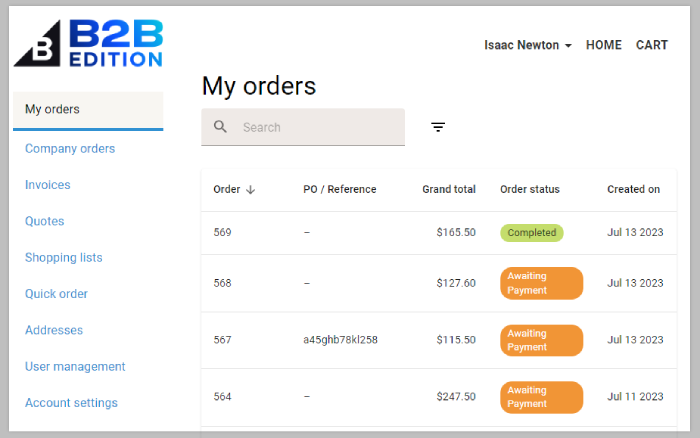
Using the legacy storefront experience? The account area for your B2B buyers has a different appearance and capabilities from the Buyer Portal. See Migrating to the Buyer Portal Experience to see a comparison of both experiences and learn how you can enable the Buyer Portal in your store.
Customers logged in to their accounts can access the Buyer Portal from the Account link in your store’s header. See the table below for a breakdown of the features available to B2C customers and B2B buyers in the Buyer Portal.
| Feature | Available for B2C customers? | Available to B2B buyers? |
|---|---|---|
| The Buyer Portal login and registration page | ✓ | ✓ |
| Viewing and creating quotes | ✓ | ✓ |
| Viewing orders placed by the logged-in customer | ✓ | ✓ |
| Viewing orders placed by other Company users | ✓ | |
| Creating and managing Shopping Lists | ✓ | ✓ |
| Approving or rejecting Shopping Lists | ✓ | |
| Quick order tools like Quick Add, Bulk Upload, and repurchasing products | ✓ | ✓ |
| Reordering from any Company order | ✓ | |
| Address book management* | ✓ | ✓ |
| Company user management | ✓ | |
| Editing account details like email address and password | ✓ | ✓ |
| Super Admin Masquerade | ✓ | |
| Invoice management | ✓ |
* The B2C address book is tied to the customer’s storefront account, while the B2B address book is tied to the Company’s account and shared across all B2B buyers in the Company.
The following features are currently not supported in the Buyer Portal:
- Wish Lists (this is replaced by Shopping Lists)
- Order messages (customers can send and reply to messages on quotes)
- Returns
- Stored payment methods
- Recently viewed products
- Store credit
- Translation apps that alter storefront URLs, such as WeGlot
Managing Company User Accounts
Company buyers with the appropriate permissions can assign users in their Company by going to the User management area in the Buyer Portal, clicking Add New User, and entering the user information.

Company users can also manage contact details and user roles for their existing users by clicking the pencil icon. To delete a user, they can click the trash can icon.

Buyers cannot create their own custom user roles. New roles be created in your B2B Edition control panel, and custom buyer permissions can only be built via the API.
Managing Company Addresses
Customers can view their saved shipping and billing addresses from the Addresses area of the Buyer Portal. This includes addresses that were added from the B2B Edition control panel.
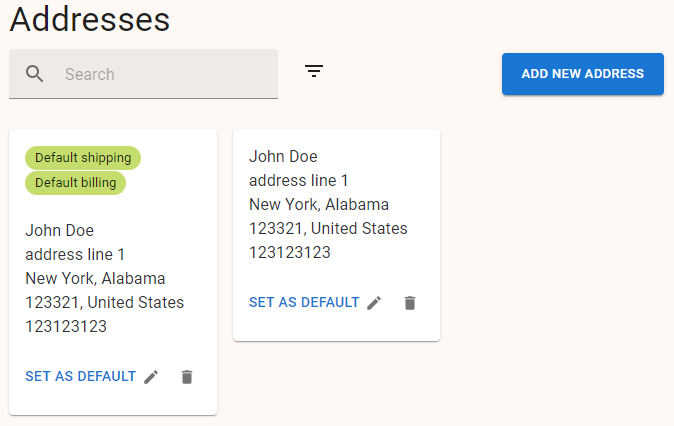
The search bar allows customers to locate specific addresses by their keywords, such as address label or postal code. They can also filter addresses by city, state, and country.
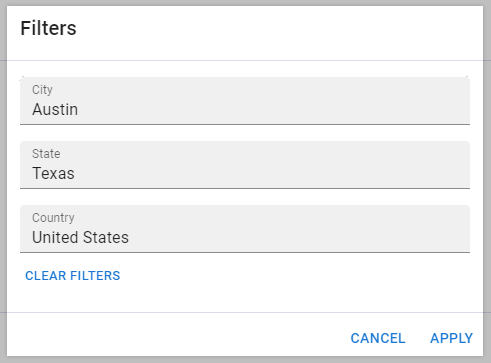
If you’ve configured it in your Address Book Management settings, buyers with Addresses permissions can edit an existing address, delete it from their address book, or set it as the default Company shipping or billing address. Default addresses automatically populate on quotes and at checkout.

Company users can use the Add New Address button to enter new address details and specify whether it is used for shipping, billing, or both.
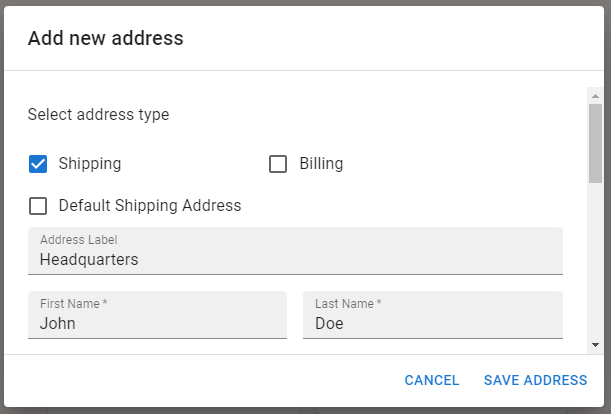
Order Management for Buyers
B2B Edition adds several tools to your storefront that optimize the process of building, repeating, and paying for orders:
- Quick order pad: Quick add
- Quick order pad: Bulk Upload CSV
- Repurchase individual products from order
- Shopping Lists
- Ordering from a Sales Staff quote
- Requesting a quote
- Reordering from any company order
Quick Order Pad: Quick Add
To add multiple items to the cart efficiently, customers can use the quick order pad located in the Quick Order area of the Buyer Portal. The quick order pad provides two methods for order creation: Quick add and Bulk Upload CSV. The Quick add option allows your customers to simply enter the desired product or variant SKUs and quantities to be added to the cart.

Quick Order Pad: Bulk Upload CSV
If a customer wants to build a large order in bulk, they can upload a CSV spreadsheet from the Quick Order area of the Buyer Portal. The import template can be found by clicking Bulk Upload CSV, then clicking Download sample in the Bulk upload window.

Once they've added the desired SKUs and quantities to the template, they can upload it to their cart either by dragging and dropping the file or using the Upload File option.
Repurchase Products from Order
For buyers that regularly repurchase certain products in your store, the Quick Order area displays a list of previously-purchased products that they can select individually or in bulk. They can use the search bar to locate specific products, or filter by date ordered. Note that buyers can only view products here from orders they have placed in this area, and not products from all Company orders.

After selecting their products, they can add them to the cart, to a quote, or to a shopping list from the Add Selected To dropdown.

Shopping Lists
Shopping Lists allow buyers with the Submit draft status for approval permission to build draft orders on your storefront which can then be approved and purchased by buyers with the appropriate permissions. They can also create Shopping Lists, but their lists will bypass the approval process.
Shopping Lists can be used by B2C customers and B2B buyers in their Buyer Portal account. If your store is using the Buyer Portal experience, we recommend disabling Wish Lists, as Shopping Lists provide improved tools for curating purchases. Since B2C customers are not a part of a Company account, they do not need to approve their own Shopping Lists before purchasing them.
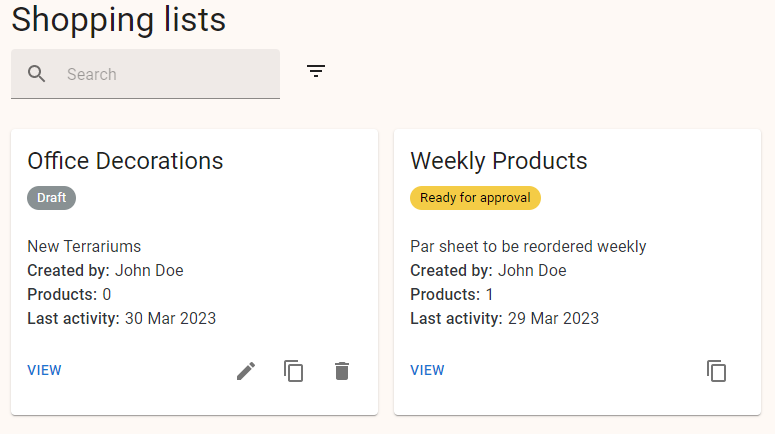
To begin assembling a Shopping List, click Create New. Shopping Lists should be given a unique name and description.

While viewing a Shopping List, customers can add products by entering the SKU or product name, or uploading a CSV file.

Customers can also add products to a shopping list from the following areas:
- Product detail pages in your storefront
- The Quick View window in product listing pages
- The list of previously-purchased products in the Quick Order area
Once all products have been added to the list, click Submit for Approval. It will then appear under Shopping Lists for buyers with the Approve draft status list permission, in Ready for Approval status. You can configure your Email settings to automatically notify Admins and Senior Buyers when a Shopping List has been submitted.

Approvers can view Shopping Lists that are awaiting approval by selecting the Ready for approval status from the Filter menu.

After viewing a submitted shopping list, approvers can click Approve or Reject to disposition the list. You can configure your Email settings to automatically notify buyers when their Shopping Lists’ status has changed.

Once approved, the approver can make further modifications to a Shopping List, such as adding items, removing them, or updating their quantities. When ready, they can select items from the list and add them to the cart or to a draft quote from the Add selected to dropdown.

When a Shopping List is rejected, it cannot be updated or re-submitted. If a user wants to re-draft a rejected Shopping List, they can use the Duplicate action to copy it and make any necessary changes.

Customers can also add out-of-stock and non-purchasable products to a Shopping List. Shopping Lists with these products cannot be purchased, and can only be converted to draft quotes if you’ve enabled it in your Quotes settings. If a customer adds a product that you’ve configured to display a “Call for pricing” message, the price will be blank in the Shopping List.

Ordering from a Sales Staff Quote
Once you have created a quote for a B2B customer, buyers with the Convert to order permission can take action on it from the Quotes area of the Buyer Portal. Quotes can be filtered by Sales Rep, creation date, and status. Company users can also change the sort order of their quotes by clicking the information columns at the top of the list.

Click on the quote to view its products, pricing, and any attachments included with it. From this page there are options to print the quote, download it as a PDF, or convert it into an order from the checkout page. You can manage how pricing is displayed and optionally disable checkout in a quote’s detail page while creating or editing it in the B2B Edition control panel.

If the default language in your Locale settings is supported by B2B Edition, the quote information in the Buyer Portal and the downloadable PDFs will display in that language. If your storefront language is not supported, the text will be in English. The following languages are supported:
- Chinese
- Dutch
- English
- French
- German
- Italian
- Japanese
- Spanish
Customers can use the Message dropdown to send any questions or comments about the quote. This will update the quote’s status in B2B Edition to Updated by Customer. Messages can be viewed by clicking on the quote in the B2B Edition control panel.

Requesting a Quote
If a buyer wants to request a quote for items in their cart, they can create a quote from the following areas:
- Product detail pages in your storefront
- The Quick View window in product listing pages
- The Add All to Quote button in the cart page
- The list of previously-purchased products in the Quick Order area
- The Add selected to quote button in approved Shopping Lists
This creates a quote in Draft status which the customer can access by clicking Finish Quote at the bottom of the storefront, or by navigating to the Quotes area of the Buyer Portal.

While viewing a drafted quote, customers can include additional products, add a quote title for easy reference, fill out their address information, include a message, and attach a file before submitting it to your B2B Edition control panel.
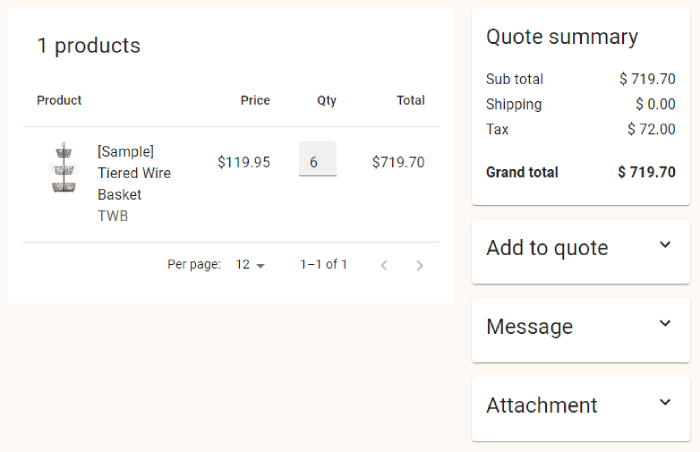
If enabled in your Quote settings, customers can add non-purchasable and out-of-stock products to quote requests. These products are listed in the draft quote with a “TBD” price until you re-submit the quote to the customer. You can adjust the wording of this placeholder price using B2B Edition’s Translation settings.

If enabled in your Quote settings, a pop-up window is displayed after a customer submits a quote request. You can customize the window’s title and message text.

If you have enabled Auto-quoting in your Quote settings, customers can immediately purchase quotes. However, if non-purchasable or out-of-stock products are added to a quote, it must first be reviewed by a sales representative.
Quote requests from customers appear in the Quotes area of the B2B Edition control panel with a default status of New. You can make edits or respond to customer messages before re-submitting the quote. Once a quote has been sent back to a customer, they can order it as they would a quote created by their sales representative.
Reordering from any Company Order
Buyers with the Purchasability permission can re-order products in previous orders by viewing the order in the Buyer Portal and clicking Re-order. From the Re-order window, they can select products and specify quantities from the original order and add them to the cart.
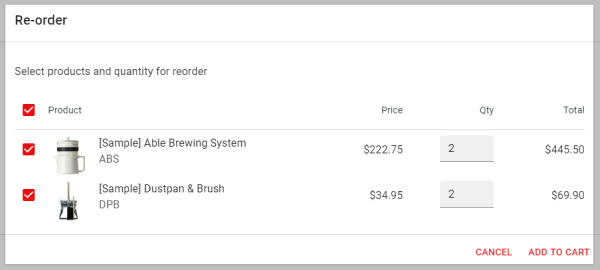
Note: If a product is out of stock or marked as not visible, buyers will be unable to add it to the cart from the Re-order window.
Checkout Experience for Buyers
When your B2B customers are ready to complete an order, they will see all of their approved payment methods at checkout.
If you have enabled the Purchase Order (PO) payment method for your customers, they can enter their Purchase Order Number/Reference Number in the text field on the payment method, as well as any other information you have requested. PO payments generate an invoice which buyers can pay within the time period specified by their Company’s payment terms.
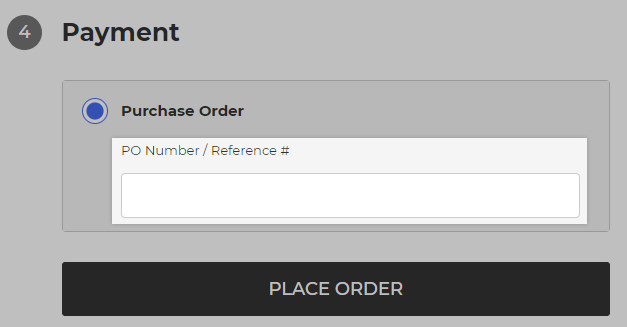
Pro Tip! You can set Company-level credit to restrict how and when your buyers can place orders with the PO payment method.
Once a PO number has been used, customers can search for previously used numbers in the Orders area of the Buyer Portal.

Adding a New Address at Checkout
If your B2B customers need to use a one-time billing or shipping address for a particular order, they can do so by clicking Enter a new Address at either the Shipping or Billing step of checkout.

By default, any addresses entered in this way will not be saved to the Company’s address book. Customers can check Save this address in my address book if they wish to keep it saved for future orders. Note that this will also save the address to the customer’s storefront account.

If you wish to restrict how your customers can use addresses at checkout, you can configure your Checkout settings to disable the creation and saving of new addresses.
Viewing Orders in the Buyer Portal
Customers can view past orders from the My orders area of the Buyer Portal. If the customer is associated with a Company account, they can also view orders placed by other Company users in the Company orders area.

In both areas, users can locate specific orders using the following methods:
- Clicking on the column name to sort by the information field
- Entering order details such as purchase order reference or line item names in the search bar
- Filtering by order status and creation date
Orders can also be sorted and filtered by purchaser from the Company orders area.
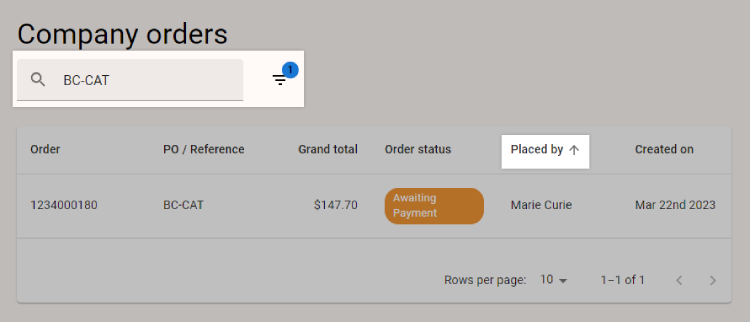
Click the order’s row in the table to go to its Order Status page. From here, users can:
- View order information like line items, subtotals, and payment method used
- View the order status history
- Print the BigCommerce order invoice
- If a B2B Edition invoice was generated for the order, navigate to the invoice in the Buyer Portal
- Repurchase the order or add its line items to a Shopping List
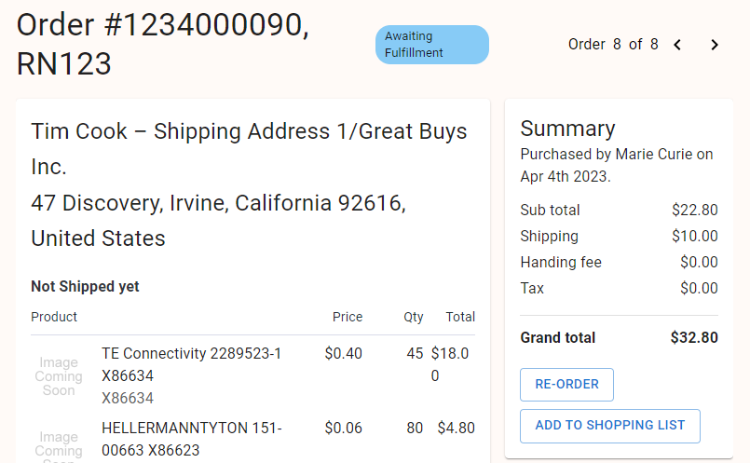
Invoice Management for Buyers
Buyers with the appropriate permissions can access the Invoices area of the Buyer Portal to pay their invoices online, no matter where the original order was placed. From here, they can view important information, such as individual invoice balances, due dates, and the total Open and Overdue balances across all invoices.
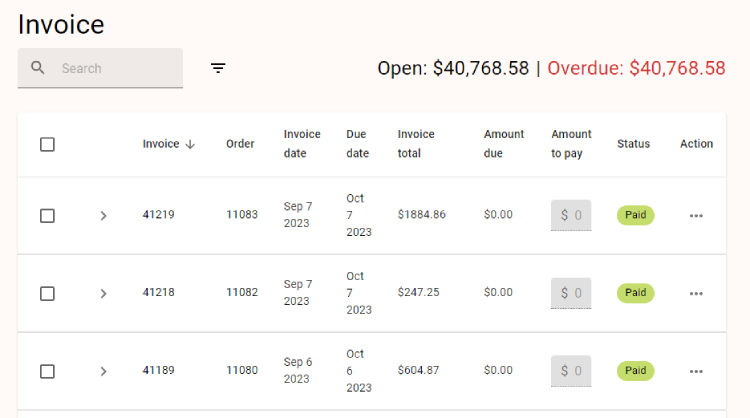
Your customers can locate specific invoices by:
- Searching for an invoice’s number or order ID
- Clicking on the header of an information column in the list to change the sort order
- Filtering invoices by status or date created
To view all invoice information in a spreadsheet, buyers can click Export All as CSV File. This creates a CSV with the same details visible from the Invoices area.

If the default language in your Locale settings is supported by B2B Edition, the headers in the invoice CSV file will display in that language. If your storefront language is not supported, the text will be in English. The following languages are supported:
- Chinese
- Dutch
- English
- French
- German
- Italian
- Japanese
- Spanish
To view detailed information on an invoice, buyers can click the drop-down arrow next to the invoice, or select View Invoice from the action menu. This opens a PDF of the invoice that displays the corresponding order, the purchase order number (if one was included), and any previous payments made on the invoice. While viewing the invoice PDF in the Buyer Portal, they can download it, print a copy, or pay the open balance.

Click the action menu next to an invoice to select from the following actions:
- View invoice — opens the invoice PDF in a new tab
- View order — opens the order that the invoice was generated from
- View payment history — if one or more payments have been made on the invoice, this displays the payment details like date, amount paid, and any memos entered during payment. This action is not available for invoices without previous payments.
- Pay — pay the remaining invoice balance. This action is not available for invoices that have been paid in full.
- Print — print a copy of the invoice
- Download — download the invoice PDF

Paying the Invoice Balance
Buyers can pay their invoices using the following methods:
- Selecting Pay from the action menu
- Clicking Pay Now while viewing the invoice PDF
- Selecting one or more invoices from the list
If they would like to pay the partial or full balance of multiple invoices at a time, they can check the boxes next to each invoice and enter the desired payment value in the Amount to pay field.

The total payment value is displayed at the bottom of the list. Buyers can click Pay Invoices to take the payment to the checkout page.

After using any of the payment actions listed above, buyers are taken to the checkout page, where they have access to the allowed payment methods configured in your Invoice settings. If the buyer is paying for multiple invoices at once, each payment is displayed as a separate line item.

The Invoice BC Pay product is used to inject the custom payment amount at checkout. This product is created automatically upon installing B2B Edition and is not visible to customers on your storefront or the Buyer Portal. Deleting this product or marking it as not purchasable will prevent Company Admin users from paying invoices in the storefront.
After making a payment, an invoice’s status is updated to Partially Paid if there is a remaining balance, or to Paid if it has been paid in full. Note that paying an invoice in the Buyer Portal or recording an external invoice payment will not automatically update the status of the corresponding order.


